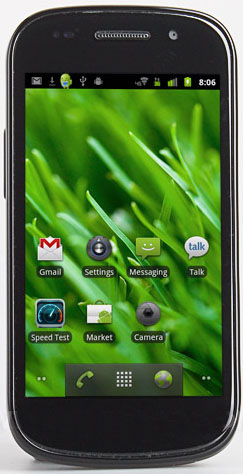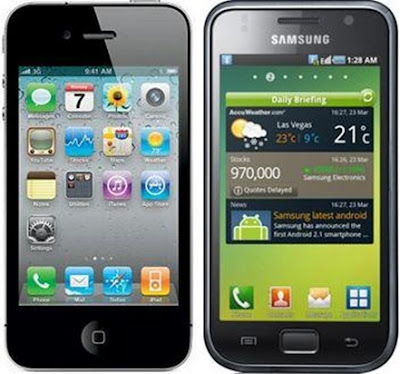
The touch screen of an Apple iPad in action.
(Credit: Apple )
Posted on 06/22/2011 2:17:08 PM PDT by Swordmaker
The U.S. Patent and Trademark Office has awarded Apple a key patent for touch screen functionality on portable devices, such as the iPhone and iPad.

Apple's patent, which the company applied for in 2007, boils down to one simple focus: when a person uses their fingers to interact with the touch screen, the software reacts to that gesture. Images that Apple included with its patent application show that functionality being implemented across several different applications, including a Web browser and a home screen.
Here's the more technical description:
"A computer-implemented method, for use in conjunction with a portable multifunction device with a touch screen display, comprises displaying a portion of page content, including a frame displaying a portion of frame content and also including other content of the page, on the touch screen display," the patent abstract reads. "An N-finger translation gesture is detected on or near the touch screen display. In response, the page content, including the displayed portion of the frame content and the other content of the page, is translated to display a new portion of page content on the touch screen display."

The patent win comes at a time when Apple is ensnared in several patent-related battles with other companies.
Nokia sued Apple in October 2009 for allegedly infringing patents related to smartphones being able to run on GSM, Wi-Fi, and 3G networks. The claims also mentioned patents Nokia owned related to mobile device security and encryption.
Apple responded with a countersuit in December 2009, alleging that Nokia violated 13 of its own patents. However, Nokia announced last week that Apple had called it quits and the companies had agreed to a patent-licensing deal. A subsequent analyst report on the matter suggested Apple's licensing costs to Nokia could reach $608 million. But Nokia is just one of Apple's problems.
In April, Samsung announced that it had filed a patent-infringement case against Apple in the U.S. District Court for the Northern District of California San Jose division, alleging that the iPhone maker violated 10 of its patents, including one that allows smartphone owners to use the Web while on a phone call. Apple alleged in its own lawsuit against Samsung in April that the company was violating patents on its user interface and mobile-device design.
The Cupertino, Calif.-based company upped the ante last week in an amended complaint, saying that Samsung has been heavily "copying" its own products.
"[Samsung's] products...blatantly imitate the appearance of Apple's products to capitalize on Apple's success," Apple wrote in its complaint. "The copying has been widely observed in the industry and has been mentioned in multiple articles reviewing Samsung products." Exactly how Apple's touch-screen patent will play into its current litigation remains to be seen. But as noted, it's a far-reaching patent, and many portable-device makers have products that allow for multitouch gestures that control software on the display.
Apple has not immediately responded to request for comment on whether or not it will use the latest patent against competitors.
“Touch screen is, not so multi-touch, especially on a portable device with gestures to do different things dependent on the motion. That is what the patent is for. “
^^^^^^^^^^^^^^^^^^
I would argue that this points out a critical flaw in patents for such things. Many “next developments” are obvious to a smart person who sits down and thinks about the same subject. They will be obvious to *any* smart person.
Name a thing, any thing, and have a group of smart people think about the “next development” of that thing. The next-generation ideas they come up with with be similar, and even the same.
A true invention is something out-of-the-blue. The “E-Cat” energy invention people are starting to talk about, if it works that would be a true innovation.
Having gestures on a touch pad is not invention. Any one of hundreds of technology thinkers could have taken out a patent on it.
Not the pads, in isolation. The claim is a combination of technology and user interaction.
I wonder if the Synaptics technology was raised as prior art, with the examiner arguing that putting the gesture "on the screen" is an obvious combination of touch screen (in general), and multi-fingertip gesture technology on a touchpad.



I’m sorry....I’m just a layperson and that really means nothing to me. All I want to know is if my phone and service are jeopardized. But thank you for your ‘in-depth’ perspective.
No, that’s not what the patent covers. What the patent would cover would be the two finger gesture to enlarge a picture or the two finger pinch to reduce it.
gotcha
That doesn’t make sense, though. It is like patenting a volume knob.
Apple is not suing Samsung on the appearance of any of the phones you so nicely cut and pasted in your comment... they are suing Samsung for the one I cut and paste in my original comment, the Galaxy SII, and others... as well as the Galaxy Tablet line. Here is another view of the Galaxy SII:


And whether the Galaxy S has Samsung emblazoned on it or not is irrelevant in a Tradedress lawsuit. Here is photo of the Galaxy S, right next to the iPhone 3Gs it was copied from:

And the VP of Samsung, in an oft quoted comment, which is being used against them in court, said, after seeing the iPad 2, "we are going to have to redesign" the Galaxy Tab 10... and they DID, recalling their already shipped to distribution heavier and thicker model, to make their's match the iPad 2's look... here's a side by side photo of the two:

So your, non sequitur photos of non-copied Samsung phones are irrelevant to the Apple v. Samsung lawsuit in Federal Court. These are... and are being litigated.
What you fail to understand is that when the volume knob was new, it WAS patented... and those who used it paid a royalty to the inventor of the volume knob, because he thought it up, not them. Perhaps, they had to use a volume slider instead.
Now, the volume knob IS obvious.
Did you know that Alexander Graham Bell (my great, great, great grandfather, incidentally) only beat Elisha Root to the patent office by a few hours with his application for the patent for the telephone... and that within a month over ten other working telephone patents were submitted to the patent office? It was an idea that was ripe... an idea who's time was ready, to personify it... so one could say it was "obvious," since twelve inventors were working on the basic idea, yet it was patentable... and my ancestor was granted the patent by being first in line. (Family lore says he may have also been the one who greased the palms the best!)
It's said that the only non-obvious invention was the phonograph. . . that no one else was working on anything similar when Thomas Edison pulled the idea out of a dream.
In this instance, no one thought of a way to implement the multi-touch gestures within a sub-window on a screen without affecting the entire window display (and that is REALLY what this invention is all about!) that worked before Apple did it on the iPhone. That means they get to patent their method, and control what's done with that technology for a time. Sure it's obvious now... but those who use it are going to have to pay the inventor (Apple) for the license to do it... if Apple will allow it to be licensed.
Gray was the inventor of the telephone... and may actually have beat Bell to the patent office...
Big mistake. You should have patented the patent first.
You mean a method for using a variable rotary potentiometer to adjust amplitude of sound output? There are several such patents (some, I'd imagine, expired by now). There isn't a patent on the concept of "make it louder," but radio manufacturers can't just copy someone else's circuits. They have to either develop their own or buy their potentiometers from the patent holder or a licensee.
>>You mean a method for using a variable rotary potentiometer to adjust amplitude of sound output?<<
Yes, but although different volume knobs work in different ways, the way the human interacts with it is the same. Some volume knobs click at each step and use a completely different signal path for each “click” of the knob. It’s like a steering wheel on a car. You can have rack and pinion, recirculating ball, or even “drive by wire”, all patentable, but the driver is just using the same ol’ steering wheel.
Google patent search turns up 20,000 patents for "steering wheel" between 1880 and 1920 alone.
And the steering wheel was patented also... and licensed for use to the other makers while that patent was in effect. The steering tiller, however, was not because of the prior art from ships, wagons, and other uses.
And the steering wheel was patented also... and licensed for use to the other makers while that patent was in effect. The steering tiller, however, was not because of the prior art from ships, wagons, and other uses.
Pure anarchistic bravo sierra from someone who has, in all likelihood, never invented a single thing in his entire life.
>>And the steering wheel was patented also...<<
I wondered about that...
Read what Apple ALSO included with the addition of those models in the amended complaint... FIVE ADDITIONAL DESIGN PATENTS and THREE HARDWARE PATENTS... not just tradedress applications. All these models include the hardware patents that Apple owns that are being infringed. It helps to read the actual complaint, not just the news article. That's why the ones you cut and paste that don't look like an iPhone were added to the suit... they infringe one or more of these actual design and hardware patents without paying proper license royalties while other models were more examples of copying the trade dress registrations. That's a lot more serious. Apple upped the ante a lot. They are showing the court a pattern of infringement of Apple's IP and look.







So, were you saying that Samsung doesn't copy the look, feel, and even the hardware patents of Apple?
Disclaimer: Opinions posted on Free Republic are those of the individual posters and do not necessarily represent the opinion of Free Republic or its management. All materials posted herein are protected by copyright law and the exemption for fair use of copyrighted works.